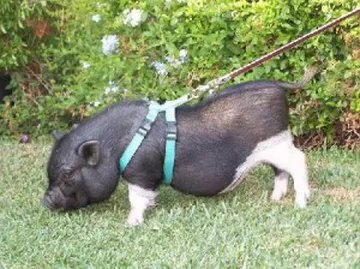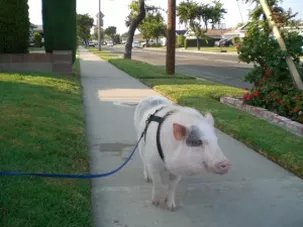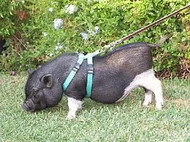PET PIGS – First Series
Nov 2nd 2011

MINIATURE POTBELLIED PIGS MAKE WONDERFUL PETS. THEY ARE CLEAN, THEY CAN BE LITTER-BOX TRAINED, THEY DON’T SHED LIKE DOGS OR CATS, NOR GET FLEAS LIKE DOGS OR CATS. THEY CAN DO TRICKS A DOG NEVER THOUGHT OF!!! THEY DON’T KEEP PEOPLE AWAKE ALL NIGHT BARKING LIKE DOGS DO, AND DON’T RUN THE NEIGHBORHOOD GOING POTTY IN NEIGHBORS YARDS. THEY CAN EVEN WALK ON A LEASH. IF YOU ARE LOOKING FOR A PET THAT’S A LITTLE DIFFERENT, THEN A MINIATURE POTBELLIED PET PIG IS THE PERFECT CHOICE!!!
Training your pig to walk with you on a leash and harness makes your life as his caregiver easier as well as allowing your pig to be safer and a closer part of your family. A leash trained pig will be easier to take with you on family outings, summer walks, and certainly to the vet.

Pigs that have already bonded to you or the family typically don’t have any trouble with harness training. If your pig doesn’t trust you, he needs to be better socialized before harness training.
Some key pointers to keep in mind…Pigs are prey animals and, as such, do not like to be restrained; it is very threatening to them. Care needs to be taken not to force your pig into a harness. Once they become scared of an object, it is very hard to relieve them of that fear. Their intelligence usually makes training them easier but it can also hinder progress if they continually feel threatened. They don’t forget much. They remember where the ScratchnAll (www.scratchnall.com) has been mounted because they enjoy using it for self-enrichment and stimulation.
To keep them from feeling scared, don’t immediately try to put the harness on the pig. Let them play with the harness first for a day or so to let them realize that the harness itself offers nothing of which to be afraid.
When putting the harness on for the first time, it can be useful to distract him by putting treats on the ground. Although he will still be aware of what you are doing, his mind will be focusing on the treats rather than this new activity. If the pig fights, reassure the him that every-thing is OK and try again. Move slowly and speak softly and do not force this first experience (if you have problems getting the harness on for the first time, give us a call and we may be able to help you out).
Once the harness is on your pig, let him run around for a few minutes. Do this a couple times a day at first, increasing the amount of time you leave the harness on the pig. You do not want the harness to be tight (they will feel restrained) nor too loose (they may get caught in objects or even slip out of the harness).
Once he is used to you putting the harness on and taking it off, you can add the leash to your routine. This shouldn’t be as stressful, but I would recommend you let him play with the leash like you did with the harness and allow him to spend time running around without any resistance (being careful to not allow the leash to get wrapped around any objects that might scare or trap him).
At the point where your pig is used to the harness and leash, you can again get out your treats and apply a little pressure to the leash. Call his name and provide a little force. Once he looks your direction or takes a step towards you, give him a treat. It’s important that they learn to look at you for guidance when they feel pressure on the leash. Continue this practice for short periods so it doesn’t seem like a chore.
When they understand that pressure means “look at you,” start to teach him to walk with you at your pace. Go slowly at first. What you want to teach is that you want him to stay close to you. Walk slowly and when he catches up, give him treats and abundant praise. Don’t scold him for not following. Always provide praise and treats for staying close to you.

